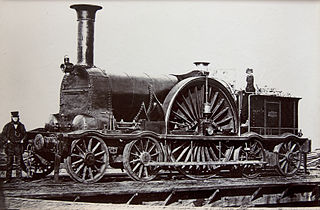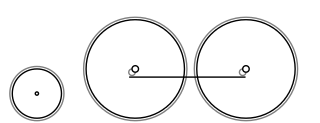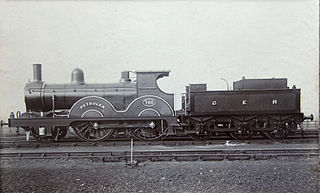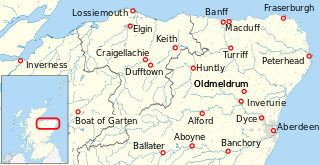
Under the Whyte notation for the classification of locomotives, 4-6-4 represents the wheel arrangement of four leading wheels, six powered and coupled driving wheels and four trailing wheels. In France where the type was first used, it is known as the Baltic while it became known as the Hudson in most of North America.

Under the Whyte notation for the classification of steam locomotives, 4-4-4 represents the wheel arrangement of four leading wheels on two axles, four powered and coupled driving wheels on two axles, and four trailing wheels on two axles. In the United States, this arrangement was named the Reading type, since the Philadelphia and Reading Railroad was the first to use it. In Canada, this type is known as the Jubilee.

Under the Whyte notation for the classification of steam locomotives, a 2-6-4 locomotive has two leading wheels, six coupled driving wheels and four trailing wheels.

Under the Whyte notation for the classification of steam locomotives, 4-2-4 represents the wheel arrangement of four leading wheels on two axles, two powered driving wheels on one axle, and four trailing wheels on two axles.
Under the Whyte notation for the classification of steam locomotives, 0-8-2 represents the wheel arrangement of no leading wheels, eight powered and coupled driving wheels on four axles, and two trailing wheels on one axle.

Under the Whyte notation for the classification of steam locomotives, 2-4-0 represents the wheel arrangement of two leading wheels on one axle, four powered and coupled driving wheels on two axles and no trailing wheels. In most of North America it became known as a Porter.

Under the Whyte notation for the classification of steam locomotives, 0-4-4 represents the wheel arrangement of no leading wheels, four powered and coupled driving wheels on two axles, and four trailing wheels on two axles. This type was only used for tank locomotives.

North Eastern Railway (NER) No. 66 Aerolite is a preserved British steam locomotive. It was classified X1 by the LNER. It was capable of reaching 55 mph.

The Metropolitan Railway K Class consisted of six 2-6-4T steam locomotives, numbered 111 to 116.

Class EE1 was an electric locomotive commissioned by the North Eastern Railway in 1922. Ownership passed to the London and North Eastern Railway in 1923 and to British Railways in 1948.

Under the Whyte notation for the classification of steam locomotives, 0-8-4 represents the wheel arrangement of no leading wheels, eight powered and coupled driving wheels on four axles, and four trailing wheels on two axles.

The London and North Eastern Railway (LNER) Class A8 was a type of 4-6-2T steam locomotive, designed by both Vincent Raven and Nigel Gresley. They were rebuilt from the LNER Class H1s, a 4-4-4T class.

The London and North Eastern Railway (LNER) Thompson Class L1 was a class of 2-6-4T steam locomotives designed by Edward Thompson. The prototype no. 9000 was built in 1945, but the remaining 99 were built under British Railways jurisdiction between 1948–1950. The prototype was well received, however the production batch were not, and all were withdrawn and scrapped between 1960 and 1962.

James Holden was an English locomotive engineer.

The GER Class T19 was a class of 2-4-0 steam tender locomotives designed by James Holden for the Great Eastern Railway. Some were later rebuilt with larger boilers while others were rebuilt with both larger boilers and a 4-4-0 wheel arrangement. Unusually, both the 2-4-0 and 4-4-0 rebuilds were classified as GER Class T19 Rebuilt. All the 2-4-0s had been withdrawn by 1920 so only the 4-4-0s passed to the London and North Eastern Railway in 1923 and these became the LNER Class D13.

The GER Class T18 was a class of fifty 0-6-0T steam locomotives designed by James Holden for the Great Eastern Railway. They passed to the London and North Eastern Railway at the grouping in 1923 and received the LNER classification J66.
The North Eastern Railway (NER) Bogie Tank Passenger (BTP) locomotives were designed by Edward Fletcher in 1873. The locomotives were for hauling passenger services on branch lines. They had an 0-4-4 wheel layout and a total of 124 locomotives were built. They were designated G6 by the London and North Eastern Railway (LNER).

The GCR Class 1B was a class of 2-6-4T (tank) locomotives on the Great Central Railway. They were notable as the first locomotives of the 2-6-4T wheel arrangement to be used by a British standard-gauge railway; there had been two narrow-gauge examples on the Leek & Manifold Valley Light Railway since 1904.

The locomotives of the Great North of Scotland Railway were used by the Great North of Scotland Railway to operate its lines in the far north-east of the country. The railway opened in 1854 with just five 2-4-0 steam locomotives, and from 1862 it used 4-4-0 exclusively as the wheel arrangement for its tender locomotives. When it expanded by amalgamation in 1866, it inherited some locomotives from these companies. It purchased most of its locomotives, although building a small number itself, two at its first works at Kittybrewster, and ten later at Inverurie Locomotive Works.
The NER Class Z was an Atlantic class of locomotives designed by Vincent Raven. It was introduced in 1911.


















